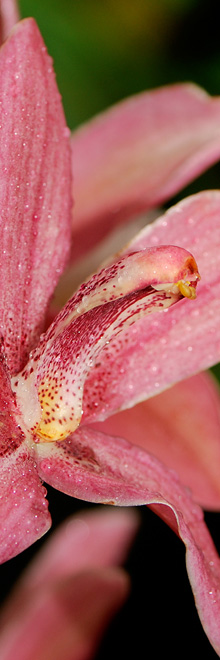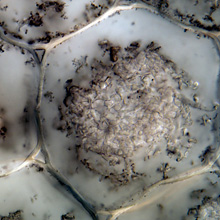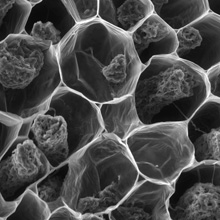Orchid mycorrhiza
Orchid mycorrhiza is an endomycorrhizal association with an extensive intracellular mycelium, occurring in the roots of the members of the Orchidaceae.
Orchid mycorrhizal fungi belong to the Basidiomycetes - most frequently to the genus Rhizoctonia (with teleomorphs Tulasnella, Sebacina, Thanatephorus, Ceratobasidium, Armillaria, Fomes etc.).
Holomycotrophic (totally dependent on mycorrhizal fungus) are all achlorophlyllous orchids (eg. Neottia nidus-avis). In general, also all germinating orchids are dependent on their mycobionts, especially in the terms of carbon metabolism, because orchid seeds contain insufficient amount of storage compounds, namely sugars, to support the development of the seedlings.
A typical anatomical feature of the orchid mycorrhiza is a coil of hyphal loops called a peloton. Pelotons develop inside the cells of the primary cortex. The fungal hypha penetrates the cortex cell, branches and forms a peloton (the cell in this phase is called a trophocyte). Cell-to-cell infection may occur after the peloton formation. At the end of their lifecycle pelotons collapse to form an aggregate of amorphic fungal tissue. The cell in this phase is called a phagocyte and can be recolonized by a new fungal hypha. Orchid mycorrhizal fungi usually do not colonize root mezodermis, endodermis and the central stele.
Orchid mycorrhiza supports host plant with nutrients, especially sugars, and water. The transport of carbon compounds from fungus to host plant may be realized by two ways: 1) through the plasmatic membrane of living pelotons (in trophocytic phase), or 2) by phagocytosis of collapsed fungal endophyte (in phagocytic phase). Recent studies support the first way of transport and regard the collapse of the hyphal pelotons rather as a result of defense mechanisms of the host plant against uncontrolled fungal development. In contrast to the general scheme of nutrient exchange in mycorrhizal symbioses, the transport of carbon from the host plant to the fungus is yet under debate in orchid mycorrhiza, even though some experimental evidence exists.


